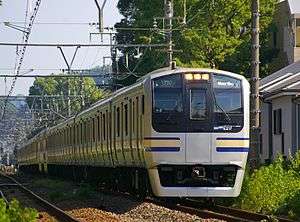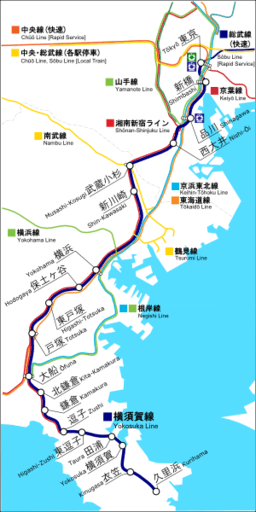Yokosuka Line
| Yokosuka Line | |||
|---|---|---|---|
| JO | |||
|
| |||
| Overview | |||
| Locale | Tokyo, Kanagawa prefectures | ||
| Termini |
Tokyo Kurihama | ||
| Stations | 19 | ||
| Operation | |||
| Opened | 1889 | ||
| Operator(s) | JR East | ||
| Technical | |||
| Line length | 73.3 km (45.5 mi) | ||
| Track gauge | 1,067 mm (3 ft 6 in) | ||
| Electrification | 1,500 V DC overhead catenary | ||
| |||
The Yokosuka Line (横須賀線 Yokosuka-sen) is a railway line in Japan operated by the East Japan Railway Company (JR East).
The Yokosuka Line connects Tokyo Station with Kurihama in Yokosuka, Kanagawa. Officially, the name Yokosuka Line is assigned to the 23.9 km segment between Ōfuna and Kurihama stations, but the entire route is commonly referred to as the Yokosuka Line by JR East for passenger service.
Basic data
Official definition
- Operators, distances:
- East Japan Railway Company (JR East) (Services and tracks)
- Ōfuna — Kurihama: 23.9 km (14.9 mi)
- Japan Freight Railway Company (JR Freight) (Services)
- Ōfuna — Zushi: 8.4 km (5.2 mi)
- East Japan Railway Company (JR East) (Services and tracks)
- Double-tracked section: Ōfuna – Yokosuka
- Railway signalling: Centralized Traffic Control (CTC)
Route as operated by JR East
- Tokyo — Kurihama: 73.3 km (45.5 mi)
- Double-tracked section: Tokyo – Yokosuka
- Railway signalling: Centralized Traffic Control (CTC)
- Maximum speed: 120 km/h (75 mph)
Route
The Yokosuka Line runs underground between Tokyo and Shinagawa (parallel to the Tōkaidō Main Line, the Yamanote Line and the Keihin-Tōhoku Line) then branches to the west along the Tōkaidō Shinkansen into the city of Kawasaki. (This alignment, technically known as the Hinkaku Line (品鶴線 Hinkaku-sen), was originally built for freight usage; see below.) It rejoins the Tōkaidō Main Line corridor near Tsurumi Station and follows the Tōkaidō Main Line to Ōfuna, where it branches off to the southeast along the original Yokosuka Line toward the Miura Peninsula.
Services
Yokosuka Line local trains make all stops. Most trains have 11 cars, with two of those being Green (first class) cars. Other trains between Tokyo and Zushi are made up of 15 cars—an 11-car set joined to a 4-car set. (Due to shorter platform length at stations south of Zushi, only 11-car trains are operated to Kurihama.) Some day-time trains operate between Zushi and Kurihama and these trains are made up of 4-car set without Green Cars. The Airport Narita rapid service operates as a local train within the Yokosuka Line.
Shōnan-Shinjuku Line local trains make all stops on the Yokosuka Line between Nishi-Ōi and Zushi.
For information on the Narita Express and other limited express services, see their respective articles.
The Yokosuka Line has through service onto the Sōbu Line to Chiba and beyond. Some trains travel as far as:
- Kazusa-Ichinomiya on the Sotobō Line
- Kimitsu on the Uchibō Line
- Narita Airport via Narita on the Narita Line (Airport Narita)
- Kashima-Jingū on the Kashima Line
- Narutō on the Sōbu Main Line
Station list
The section between Yokosuka and Kurihama is single-tracked; trains can only pass one another at Kinugasa and Kurihama stations.
| Official line name | No. | Station | Japanese | Distance (km) | Liner | Transfers | Location | |||
|---|---|---|---|---|---|---|---|---|---|---|
| Between stations |
Total | |||||||||
| Tōkaidō Main Line | TYO JO 19 |
Tokyo | 東京 | - | 0.0 | ● |
|
Chiyoda | Tokyo | |
SMB JO 18 |
Shimbashi | 新橋 | 1.9 | 1.9 | ● |
|
Minato | |||
SGW JO 17 |
Shinagawa | 品川 | 4.9 | 6.8 | ● |
| ||||
JO 16 |
Nishi-Ōi | 西大井 | 3.6 | 10.4 | | | JS Shōnan-Shinjuku Line (for Ōsaki) | Shinagawa | |||
MKG JO 15 |
Musashi-Kosugi | 武蔵小杉 | 6.4 | 16.8 | | |
|
Nakahara-ku, Kawasaki | Kanagawa | ||
JO 14 |
Shin-Kawasaki | 新川崎 | 2.7 | 19.5 | | | Saiwai-ku, Kawasaki | ||||
| N/A | Tsurumi | (鶴見) | 5.1 | via Shin- Kawasaki 24.6 |
via Kawasaki 21.7 |
| | Official branch point only; no trains serve this station | Tsurumi-ku, Yokohama | ||
YHM JO 13 |
Yokohama | 横浜 | 7.1 | 31.7 | 28.8 | | |
|
Nishi-ku, Yokohama | ||
JO 12 |
Hodogaya | 保土ヶ谷 | 3.0 | 34.7 | 31.8 | | | Hodogaya-ku, Yokohama | |||
JO 11 |
Higashi-Totsuka | 東戸塚 | 4.9 | 39.6 | 36.7 | | | Totsuka-ku, Yokohama | |||
TTK JO 10 |
Totsuka | 戸塚 | 4.2 | 43.8 | 40.9 | | |
| |||
OFN JO 09 |
Ōfuna | 大船 | 5.6 | 49.4 | 46.5 | ● |
|
Kamakura | ||
| Yokosuka Line | from Ofuna 0.0 | |||||||||
JO 08 |
Kita-Kamakura | 北鎌倉 | 2.3 | 51.7 | 2.3 | | | ||||
JO 07 |
Kamakura | 鎌倉 | 2.2 | 53.9 | 4.5 | ● | Enoshima Electric Railway (Enoden) | |||
JO 06 |
Zushi | 逗子 | 3.9 | 57.8 | 8.4 | ● | KK Keikyū Zushi Line (Shin-Zushi) | Zushi | ||
JO 05 |
Higashi-Zushi | 東逗子 | 2.0 | 59.8 | 10.4 | |||||
JO 04 |
Taura | 田浦 | 3.4 | 63.2 | 13.8 | Yokosuka | ||||
JO 03 |
Yokosuka | 横須賀 | 2.1 | 65.3 | 15.9 | KK Keikyū Main Line (Hemi, Shioiri) | ||||
JO 02 |
Kinugasa | 衣笠 | 3.4 | 68.7 | 19.3 | |||||
JO 01 |
Kurihama | 久里浜 | 4.6 | 73.3 | 23.9 | KK Keikyū Kurihama Line (Keikyū Kurihama) | ||||
History
The Yokosuka Line was constructed in response to the request to the Cabinet by the Navy and the Army, dated June 22, 1886, citing the lack of ground transportation to Yokosuka, one of the most important military bases in the country. On April 22, 1887 the Cabinet ordered the Government Railways to build the line with the budget diverted from the fund for the Tōkaidō Line construction. After the survey from July to December 1887, the construction of the railway between Ōfuna and Yokosuka started in January 1888 and completed in June 1889 spending 408,480 yen in total. The operation of the line started on June 16, 1889.[1]
Chronology
- June 16, 1889: Line opens between Ōfuna and Yokosuka with intermediate stations at Kamakura and Zushi
- April 1, 1895: Line becomes part of the Tōkaidō Line
- May 1, 1904: Taura Station opens
- October 12, 1909: Line renamed the Yokosuka Line
- August 12, 1914: Line doubled-tracked between Zushi and Numama Signal Box (newly built between Zushi and Taura)
- September 13, 1916: Line doubled-tracked between Ōfuna and Kamakura
- March 1917: Line doubled-tracked between Kamakura and Zushi
- October 20, 1920: Line doubled-tracked between Numama Signal Box and Taura
- December 25, 1924: Line doubled-tracked between Taura and Yokosuka
- December 23, 1925: Entire line electrified; electric locomotives begin operation between Tokyo and Yokosuka
- May 20, 1927: Kita-Kamakura Station (temporary) opens
- March 15, 1930: Service with electric multiple units (EMU) begins
- October 1, 1930: Kita-Kamakura Station becomes a permanent station
- April 1, 1944: Line was extended to Kurihama; Kinugasa Station opens
- April–August 1945: Sagami-Kanaya Station (temporary) is operated to serve a military base between Yokosuka and Kinugasa
- April 1, 1952: Higashi-Zushi Station opens
- June 16, 1968: Luggage on a Yokosuka Line train exploded near Ōfuna Station, killing one and injuring 14. The culprit, a man in his 20s, testified that he had not meant to kill anyone, but to frighten his ex-fiancée, who had left him for an acquaintance; however, he was ultimately convicted and sentenced to death.
- October 1, 1974: Freight service abolished between Yokosuka and Kurihama
- October 1, 1976: New double-tracked underground line between Tokyo and Shinagawa opens; Sōbu Line (Rapid) trains terminate at Shinagawa
- October 1, 1980: Separated Tōkaidō Line tracks between Tokyo and Ōfuna opened for Yokosuka Line service; Shin-Kawasaki, Higashi-Totsuka stations open; Hodogaya Station served only by Yokosuka Line trains
- February 1, 1984: Freight service abolished between Yokosuka and Zushi
- April 2, 1986: Nishi-Ōi station opens
- May 2, 1998: Through service to Zushi from the Yokohama and Negishi lines are operated on weekends and holidays
- December 1, 2001: Shōnan-Shinjuku Line begins operation
- October 16, 2004: Major revision of Shōnan-Shinjuku Line services; Shinjuku-terminating trains abolished
- May 1, 2006: JR Freight ceases operations between Taura and Zushi
- March 15, 2008: Weekend/holiday through service to Zushi from the Yokohama and Negishi lines is abolished; new Yokosuka Line platform installed at Shinagawa Station
- March 13, 2010: Yokosuka Line service at Musashi-Kosugi Station commences
- March 13, 2015: Ohayō Liner Zushi and Home Liner Zushi are abolished.
Hinkaku Line
The Hinkaku Line (品鶴線 Hinkaku-sen) was originally built to divert freight traffic from the busy Tōkaidō Main Line, providing an alternate route between Tokyo and Tsurumi. After a 1967 explosion, freight trains were banned from portions of the central Tokyo rail network, providing the impetus for the construction of the orbital Musashino Line. The new Musashino Line was connected to the Hinkaku Line roughly 6 km north of Tsurumi Station near Musashi-Kosugi, siphoning off nearly all freight traffic after its opening in 1975. This left a substantial chunk of the double-tracked, mostly grade-separated Hinkaku Line disused.
In order to put the line back into passenger service, a new 6 km track was installed between Tsurumi Station and the Musashino Line, where it was connected to the now-disused portion of the Hinkaku Line. Two new stations were constructed: one (Shin-Kawasaki) adjacent to the existing Kashimada Station on the Nambu Line in 1980 and another at Nishi-Ōi in 1986. Musashi-Kosugi Station, the third station in this section opened in 2010 and provides a transfer to the Nambu Line as well as the Tōkyū Tōyoko and Meguro lines.
References
External links
| Wikimedia Commons has media related to Yokosuka Line. |
- Stations of the Yokosuka Line (JR East) (in Japanese)


.svg.png)